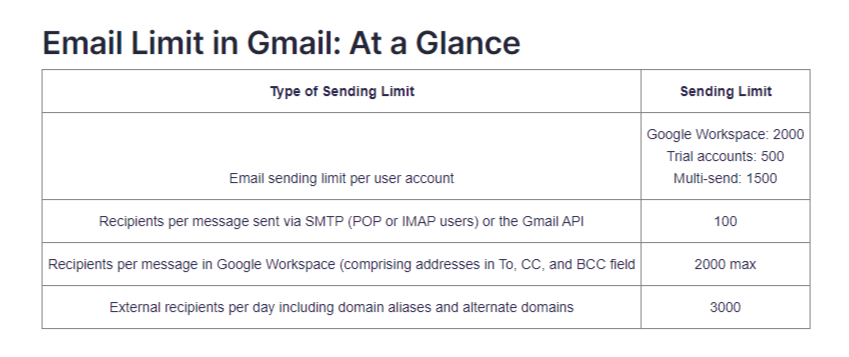Maximum Gmail Recipient Limit?
Google restricts the number of emails you can send each day based on the number of recipients emailed from an authorized Gmail or Google Workspace account. In Gmail recipient limit Does Google considers a recipient to be a single or more? Google considers a recipient to be a single unique email address, and any email sent to them within a 24-hour period counts as one.
The maximum restriction applies to all emails you send each day, not just bulk emails. Each email you send to a different recipient counts as one email. So, if you send four individual emails to your boss on different work issues, two preview copies of your mass email message as testing, and then put your boss in the final mass email distribution list, it will count as seven emails (4+2+1).
Similarly, if you used the same email address to send a meeting reminder to 85 members of your car club, that would be considered 85 emails.
That’s why it can be beneficial to set up a separate email account with your webmail provider for bulk emails, especially if you have a large mailing list.
What is the Maximum Number of Gmail Recipient Limit Each Day?
Gmail’s email sending limit for a regular account or a Google Workspace trial account is 500 emails per day. With a Google Workspace premium account, each user account has a daily sending limit of 2000 emails.
Aside from the daily sending limit, there are several minor distinctions between Gmail accounts and Google Workspace. Let us take a closer look to better understand:
1) Gmail Account
The free Gmail account allows you to send 500 emails or recipients, which means you can only reach out to 500 people every day and it is the proper Gmail recipient limit. It means you can send one email to 500 recipients or five emails to 100 recipients each.
The transmitting restriction is not established at a single time of day, but rather over a rolling 24-hour period.
2) G Suite Account
Every email sent with Google Workspace (G Suite) takes into account each individual email address. It means that if you send 10 emails to 30 different recipients, the total number of recipients will be 300.
Although the G Suite email limit per day is 10,000, if you send 2000 emails to 2000 people, you will be unable to send emails to the remaining 8000 receivers for the next 24 hours. To bypass the sending limit and reach all 10,000 recipients, send 2000 emails to 5 recipients each via the ‘CC’ and ‘BCC’ fields.
Important: All of the email addresses supplied in the ‘To’, ‘CC’, and ‘BCC’ boxes are counted as individual recipients per message.
3) Free trial period
Anyone using the free trial period for a Google Workspace account is limited to 500 emails unless they upgrade to the full premium version and finish a 60-day waiting period.
4) Email alias
Using an email alias does not affect your Gmail recipient limit. Your primary account address and all of its aliases count toward a single daily email limit. Therefore, if your account has two email names, [email protected] and [email protected]. Every has a limit per day of 500 for a Gmail account as well as 2,000 for a paid Google Workspace account.
If you exceed these limitations, your account may be terminated for up to 24 hours. You are still getting emails in your mailbox and using various Google account features like your calendar, but you can’t send them right now.
Read More: If you frequently exceed your Gmail recipient limit and require a dependable way to handle your emails, the SysTools Gmail Backup Tool can help. This program allows you to easily backup your Gmail data, ensuring that you never lose essential emails. It also allows you to export emails to multiple formats and schedule frequent backups, making it easier to manage your email communications.
Gmail BCC limit: How many emails can be BCC’d in Gmail?
When you CC or BCC an email address in an email, Google treats each unique address as a separate email. Exactly like the addresses you provide in the TO line. As a result, there is no numerical advantage to including an address on the CC or BCC lines. In other words, moving names to BCC or CC does not boost your Gmail recipient limit
Some emailers utilize the BCC line to transmit to many recipients without disclosing their identities to the entire group. Technically, this works, but it is not regarded as a best practice because it is a holdover from a period. When everyone could afford to utilize an advanced email marketing service. What used to cost $1,000 or more a month in the early days of such services now costs as little as $12.95.
For example, when you use GMass, even if you include many email addresses in the TO line. Each email is sent separately, and recipients see only their own name – no one else’s. This is not only a best practice, but it also has the added benefit of increasing email deliverability rates. It is critical for any mass email sender looking to avoid their receivers’ spam folders.
Conclusion
Understanding Gmail recipient limit or restrictions is critical to good email handling. Normal Gmail accounts can send 500 emails per day, whereas Google Workspace accounts can deliver up to 2,000. Following these principles will help you keep within your restrictions, preserve account functionality, and increase email deliverability.


